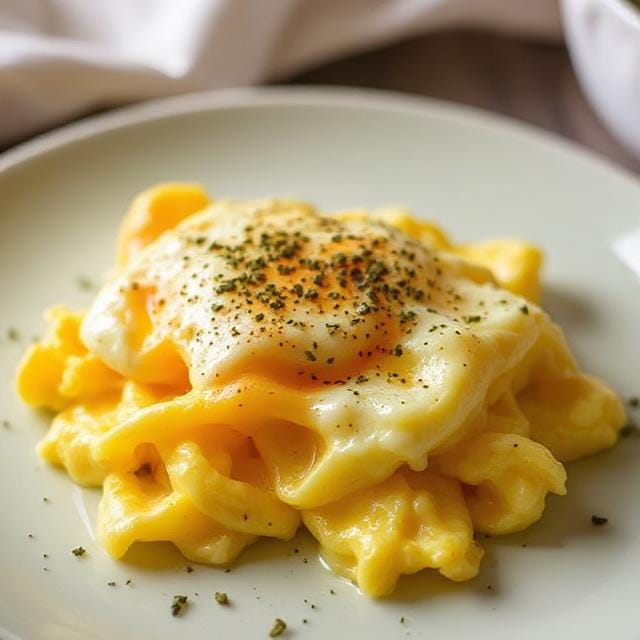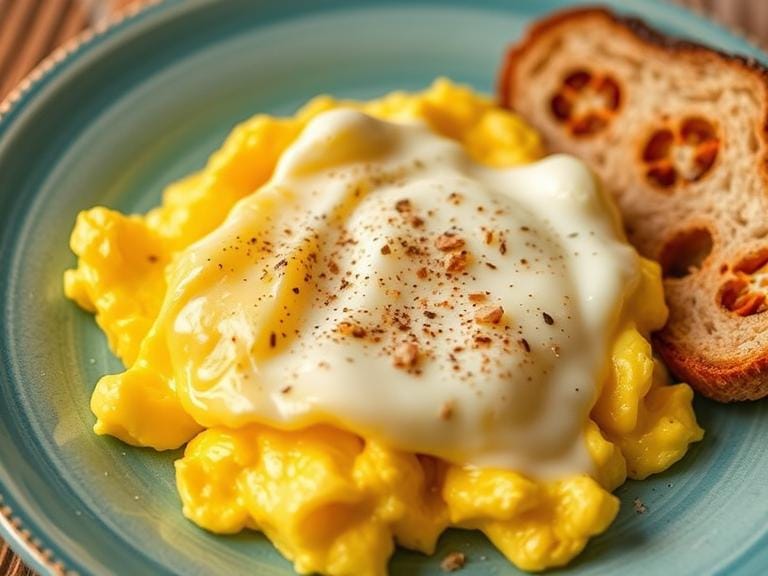The Comfort of a Perfect Plate of Scrambled Eggs
There’s something deeply satisfying about a plate of scrambled eggs done just right. Maybe it reminds you of Sunday mornings in your childhood home or that time you nailed breakfast for your partner. Whatever the memory, scrambled eggs bring comfort, nostalgia, and warmth to your kitchen. Yet despite being such a simple dish, it’s surprisingly easy to get wrong. Too dry, too wet, bland, or rubbery – we’ve all been there. But you’re about to change that.
This guide is here to help you master the subtle art of making scrambled eggs. Whether you’re just starting to cook or you’ve been at it for years, there’s always a way to upgrade your technique. Let’s make every bite fluffy, flavorful, and unforgettable.
What Are Scrambled Eggs?
A Simple Dish with Global Popularity
At its core, scrambled eggs are just beaten eggs cooked over medium-low heat until they’re soft and creamy. But across the world, cultures have taken this humble dish and turned it into something magical. From the silky French technique to the spicy Indian Anda Bhurji, scrambled eggs have as many personalities as there are kitchens.
They’re quick, versatile, and budget-friendly, making them a favorite for breakfasts, quick dinners, and everything in between.
Nutritional Benefits of Scrambled Eggs
When you make them with quality ingredients, scrambled eggs can be a nutritional powerhouse:
- Protein-rich: Around 6 grams of protein per egg
- Healthy fats: Especially when cooked with butter or olive oil
- Vitamins and minerals: B12, vitamin D, iron, and selenium
- Customizable: Add veggies, herbs, or lean meats for added nutrition

Ingredients You’ll Need for Scrambled Eggs
Making the perfect scrambled eggs starts with quality ingredients. Here’s what you’ll need:
| Ingredient | Quantity | Notes |
|---|---|---|
| Eggs | 2-3 per person | Use organic or free-range for best flavor |
| Milk/Cream (optional) | 1–2 tbsp | Makes eggs creamier (optional) |
| Butter or Oil | 1 tbsp | Unsalted butter is ideal |
| Salt & Pepper | To taste | Use sea salt and freshly cracked pepper |
| Optional Add-ins | As desired | Cheese, herbs, veggies, meats |
Your eggs are only as good as the ingredients you use. Opt for farm-fresh eggs whenever possible.
Tools You’ll Need to Make Scrambled Eggs
The right tools help make the process smoother and the results tastier:
- Non-stick skillet: Prevents sticking and ensures even cooking
- Silicone spatula: Gentle on your eggs and your pan
- Mixing bowl and whisk/fork: For thorough beating
- Stovetop or induction burner: Helps control temperature better than a microwave
You don’t need fancy gadgets. Just reliable, heat-safe tools that treat your ingredients right.
How to Make Scrambled Eggs Step-by-Step
Let’s walk through the process together so you can start mastering the basics.
1. Crack and Beat the Eggs
- Crack your eggs into a bowl.
- Add salt, pepper, and optional cream or milk.
- Beat them well with a fork or whisk until fully combined and slightly frothy.
Pro Tip: Beating air into your eggs makes them fluffier.
2. Heat the Pan
- Place your non-stick skillet over medium-low heat.
- Add your butter and let it melt slowly. It should foam, not brown.
Pro Tip: Too much heat = rubbery eggs. Keep it low and slow.
3. Cook the Eggs Gently
- Pour in the beaten eggs.
- Stir slowly and constantly with your spatula, scraping from the bottom.
- You’ll see soft curds forming. That’s a good sign!
4. Remove While Slightly Underdone
- Once the eggs are mostly cooked but still glossy and slightly wet, remove the pan from heat.
- Residual heat will finish cooking them.
5. Season and Serve
- Taste and adjust the seasoning if needed.
- Serve immediately with toast, avocado, or your favorite toppings.
Optional Toppings: Chives, grated cheese, smoked paprika, hot sauce, caramelized onions
Tips for Perfect Scrambled Eggs Every Time
You know the basic steps. Now let’s fine-tune your skills:
- Use fresh eggs – Better structure, better taste
- Low and slow – Avoid rushing; your patience will be rewarded
- Don’t overcrowd – Cook only 2-4 eggs at a time for better control
- Stir gently – Aggressive stirring breaks the curds
- Cook in butter – Adds richness and prevents sticking
Want fluffier eggs? Add a splash of sparkling water instead of milk.

Variations of Scrambled Eggs Around the World
If you think scrambled eggs are boring, think again. Here are international takes to spice up your plate:
- French-style: Very soft and silky; cooked over very low heat with continuous stirring
- American-style: Fluffy, firmer, often cooked quickly over medium heat
- British-style: Creamier, often made with added milk or cream
- Indian-style (Anda Bhurji): Spiced with turmeric, chili, garlic, onions, and coriander
- Japanese-style (Tamagoyaki): Lightly sweet, rolled, and sliced
Common Mistakes When Making Scrambled Eggs
Let’s avoid the common pitfalls that lead to disappointing results:
- Cooking on high heat: Results in rubbery or browned eggs
- Not whisking properly: Leaves streaks of whites
- Adding salt too late: Doesn’t distribute flavor evenly
- Overcooking: Destroys moisture and creaminess
- Neglecting the pan: Using cast iron or stainless steel can lead to sticking
Mastering scrambled eggs is more about patience and awareness than anything else.
You can try also Steak And Eggs Breakfast
Frequently Asked Questions About Scrambled Eggs
How many eggs should I use per person?
Generally, 2 to 3 eggs per person is perfect. If serving with sides or in a sandwich, 2 will do.
Ought to I utilize drain or cream in mixed eggs?
You can! Milk makes them lighter, while cream adds richness. But both are optional.
Can I make scrambled eggs in the microwave?
Yes, though the texture won’t be as creamy. Stir frequently and heat in 30-second intervals.
Why do my scrambled eggs turn green or grey?
That usually happens due to overcooking or using an aluminum pan. Cook gently and use non-reactive cookware.
How do I store and reheat scrambled eggs?
Store in an air proof holder within the cooler for up to 3 days. . Warm on moo warm with a sprinkle of drain to reestablish dampness.
Conclusion – Your Scrambled Eggs, Your Style
You don’t need to be a chef to make scrambled eggs that make people pause and smile. You just need the right technique, a little patience, and a willingness to experiment. From smooth and custardy to fluffy and hearty, scrambled eggs adapt to your taste and style.
So next time you reach for the eggs, remember this guide. Make it your morning ritual or your late-night snack. Either way, you’ve got what it takes to make it perfect.
Ready to Try It Yourself?
Don’t just read about it—go cook! Pick your style, gather your ingredients, and let your pan tell the story. And when you nail that perfect plate, snap a photo and share it. Someone else out there might be searching for their eggspiration too.
What’s your favorite way to make scrambled eggs? Let us know in the comments!



